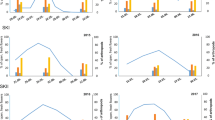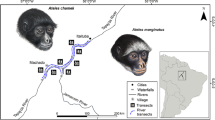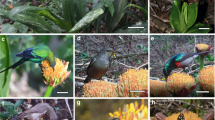Abstract
The foraging patterns of Osmia cornifrons (Radoszkowski) (Megachilidae, Hymenoptera) were determined with an immunomarking method and correlated with fruit set in a commercial tart cherry orchard in Pennsylvania. Adults of O. cornifrons were self-marked with chicken egg-white protein powder from a dispenser nest box placed at the center of the study orchard at early bloom. Flower samples were collected from randomly selected trees (n = 30) located at different distances from the nest box. Flowers were analyzed for the presence of immunomarker protein with enzyme-linked immunosorbent assay. Foraging patterns were determined by measuring the distance and direction of marked flowers from the nest box. While marked flowers were found out to 55 m (maximum distance sampled), most marked flowers were found within 35 m from the nest and the percentage of marked flowers declined rapidly beyond that distance. Fruit density per limb cross-sectional area (cm2) in the study orchard was significantly higher than in the orchard without O. cornifrons, indicating the value of O. cornifrons as pollinators in increasing fruit yield in tart cherries.




Similar content being viewed by others
References
Akey, D.H., Hayes, J.L., Fleischer, S.J. (1991) Use of elemental markers in the study of arthropod movement and trophic interactions. Southwest. Entomol Suppl. 14, 1–87
Batra, S.W.T. (1979) Osmia cornifrons and Pithitis smaragdula, two Asian bees introduced into the United States for crop pollination. Maryland Agricultural Experiment Station, Special Miscellaneous Publication 1, 307–312
Batra, S.W.T. (1998) Hornfaced bees for apple pollination. Am. Bee J. 138, 364–365
Biddinger, D.J., Mullin, C., Frazier, J., Frazier, M., Ashcraft, S., Rajotte, E. (2011a) Assessing the pesticide susceptibility of native bees in Pennsylvania orchards. Penn Fruit News 91, 49–55
Biddinger, D., Rajotte, E., Joshi, N., Ritz, A. (2011b) Wild bees as alternative pollinators. Fruit Times 30, 1–4
Biddinger, D.J., Ngugi, H., Frazier, J., Frazier, M., Leslie, T., Donovall, L.R. (2010) Development of the mason bee, Osmia cornifrons, as an alternative pollinator to honey bees and as a targeted delivery system for biological control agents in the management of fire blight. Penn Fruit News 90, 35–44
Biddinger, D., Frazier, J., Frazier, M., Rajotte, E., Donovall, L., Leslie, T. (2009a) Solitary bees as alternative pollinators in Pennsylvania fruit crops. Penn Fruit News 89, 84–94
Biddinger, D.J., Ngugi, H., Frazier, J. (2009b) Development of the mason bee, Osmia cornifrons, as a targeted delivery system for biocontrol agents in the management of fire blight. Penn Fruit News 89, 95–100
Blackmer, J.L., Hagler, J.R., Simmons, G.S., Canas, L.A. (2004) Comparative dispersal of Homalodisca coagulata and Homalodisca liturata (Homoptera: Cicadellidae). Environ. Entomol. 33, 88–99
Blackmer, J.L., Hagler, J.R., Simmons, G.S., Henneberry, T.J. (2006) Dispersal of Homalodisca vitripennis (Homoptera: Cicadellidae) from a point release site in citrus. Environ. Entomol. 35, 1617–1625
Bosch, J., Kemp, W.P. (2002) Developing and establishing bee species as crop pollinators: the example of Osmia spp. (Hymenoptera: Megachilidae) and fruit trees. Bull. Entomol. Res. 92, 3–16
Bosch, J., Kemp, W.P. (2006) Bee population returns and cherry yields in an orchard pollinated with Osmia lignaria (Hymenoptera: Megachilidae). J. Econ. Entomol. 99, 408–413
Bosch, J., Kemp, W., Trostle, G. (2006) Bee population returns and cherry yields in an orchard pollinated with Osmia lignaria (Hymenoptera: Megachilidae). J. Econ. Entomol. 99, 408–413
Bosch, J., Sgolastra, F., Kemp, W.P. (2008) Life cycle ecophysiology of Osmia mason bees used as crop pollinators, pp. 83–103. In R. R. James and T. L. Pitts-Singer [eds.], Bee pollination in agricultural ecosystems. Oxford University Press, New York.
Buczkowski, G., Bennett, G. (2006) Dispersed central-place foraging in the polydomous odorous house ant, Tapinoma sessile as revealed by a protein marker. Insectes Soc. 53, 282–290
Chaplin, M.H., Westwood, M.N. (1980) Relationship of nutritional factors to fruit set. J. Plant Nutr. 2, 477–505
Gathmann, A., Tscharntke, T. (2002) Foraging ranges of solitary bees. J. Anim. Ecol. 71, 757–764
Greenleaf, S.S., Williams, N.M., Winfree, R., Kremen, C. (2007) Bee foraging ranges and their relationship to body size. Oecologia 153, 589–596
Guedot, C., Bosch, J., Kemp, W.P. (2009) Relationship between body size and homing ability in the genus Osmia (Hymenoptera: Megachilidae). Ecol. Entomol. 34, 158–161
Hagler, J.R. (1997) Field retention of a novel mark-release-recapture method. Environ. Entomol. 26, 1079–8
Hagler, J.R., Jackson, C.G. (1998) An immunomarking technique for labeling minute parasitoids. Environ. Entomol. 27, 1010–16
Hagler, J.R., Jones, V.P. (2010) A protein-based approach to mark arthropods for mark-capture type research. Entomol. Exp. Appl. 135, 177–192
Hagler, J.R., Naranjo, S.E. (2004) A multiple ELISA system for simultaneously monitoring intercrop movement and feeding activity of mass-released insect predators. Int. J. Pest Manag. 50, 199–207
Hagler, J.R., Cohen, A.C., Dradley-Dunlop, D., Enriquez, F.J. (1992) New approach to mark insects for feeding and dispersal studies. Environ. Entomol. 21, 20–25
Hagler, J., Mueller, S., Teuber, L.R., Van Deynze, A., Martin, J. (2011a) A method for distinctly marking honey bees, Apis mellifera, originating from multiple apiary locations. J. Insect Sci. 11:143 available online: insectscience.org/11.143
Hagler, J.R., Mueller, S., Teuber, L.R., Machtley, S.A., Van Deynze, A. (2011b) Foraging range of honey bees, Apis mellifera, in alfalfa seed production fields. J. Insect Sci. 11:144 available online: insectscience.org/11.144
Jones, V.P., Hagler, J.R., Brunner, J.F., Baker, C.C., Wilburn, T.D. (2006) An inexpensive immunomarking technique for studying movement patterns of naturally occurring insect populations. Environ. Entomol. 35, 827–836
Joshi, N. K., Biddinger, D., Rajotte E.G. (2011) A survey of apple pollination practices, knowledge and attitudes of fruit growers in Pennsylvania. 10th International Pollination Symposium, Puebla, Mexico.
Kitamura, T., Maeta, Y. (1969) Studies on the pollination of apple by Osmia: (III) Preliminary report on the homing ability of Osmia cornifrons (Radoszkowski) and O. pedicornis Cockerell. Kontyu 37, 83–90
Kuhn, E.D., Ambrose, J.T. (1984) Pollination of ‘Delicious’ apple by megachilid bees of the genus Osmia (Hymenoptera: Megachilidae). J. Kans. Entomol. Soc. 57, 169–180
Maccagnani, B., Ladurner, E., Santi, F., Burgio, G. (2003) Osmia cornuta (Hymenoptera, Megachilidae) as a pollinator of pear (Pyrus communis): Fruit- and seed-set. Apidologie 34, 207–216
Maccagnani, B., Bazzi, C., Biondi, E., Tesoriero, D., Maini, S. (2006) Potential of Osmia cornuta as a carrier of antagonistic bacteria in biological control of fire blight: a comparison with Apis mellifera. Acta Hortic. 704, 379–386
Mader, E., Spivak, M., Evans, E. (2010) Managing alternative pollinators: a handbook for beekeepers, growers and conservationists. Sustainable Natural Resource and Education Program handbook; 11, NRAES Cooperative Extension, Ithaca, NY. 162 pp.
Maeta, Y. (1990) Utilization of wild bees. Farming Japan 24, 13–22
Maeta, Y. (1978) Comparative studies on the biology of the bees of the genus Osmia of Japan, with special reference to their managements for pollinations of crops (Hymenoptera: Megachilidae). Tohoku National Agricultural Experiment Station. Bulletin No. 57, 221
Maeta, Y., Kitamura, T. (1974) How to manage the Mame-ko bachi, Osmia cornifrons (Radodoskowski), for pollination of fruit crops. Co. Ltd., Ask. 28 p
Monzon, V.H., Bosch, J., Retana, J. (2004) Foraging behavior and pollinating effectiveness of Osmia cornuta and Apis mellifera (Hymenoptera: Megachilidae, Apidae) on 'Comice' pear. Apidologie 35, 575–585
van Nieuwstadt, M.G.L., Ruano Iraheta, C.E. (1996) Relation between size and foraging range in stingless bees (Apidae, Meliponinae). Apidologie 27, 219–228
Radmacher, S., Strohm, E. (2010) Factors affecting offspring body size in the solitary bee Osmia bicornis (Hymenoptera, Megachilidae). Apidologie 41, 169–177
Ritz, A., Biddinger, D., Rajotte, E., Sahli, H., Joshi, N. (2012) Quantifying the efficacy of native bees for orchard pollination in Pennsylvania to offset the increased cost and decreased reliability of honey bees. Penn Fruit News 92, 6–66
Schneider, F. (1962) Dispersal and migration. Ann. Rev. Entomol. 7, 223–242
Schupp, J.R., Greene, D.W. (2002) Thinning Mcintosh apple trees with blossom thinners, with and without post-bloom NAA: A report to the New England Tree Fruit Growers Research Committee. Fruit Notes 67, 9–12
Sekita, N., Watanabe, T., Yamada, M. (1996) Population ecology of Osmia cornifrons (Hymenoptera, Megachilidae) in natural habitats. Bulletin of the Aomori Apple Experiment Station 29, 17–36
Sekita, N., Yamada, M. (1993) Use of Osmia cornifrons (Radoszkowski) for pollination of apples in Aomori Prefecture, Japan. JARQ Japan Agricultural Research Quarterly 26, 264–270
Torchio, P.F. (1981) Field experiments with Osmia lignaria propinqua Cresson as a pollinator in almond orchards: II, 1976 studies (Hymenoptera: Megachilidae). J. Kans. Entomol. Soc. 54, 824–836
Vincens, N., Bosch, J. (2000) Nest site orientation and relocation of populations of the orchard pollinator Osmia cornuta (Hymenoptera: Megachilidae). Environ. Entomol. 29, 69–75
Xu, H.-L., Yang, L.-I., Kwon, Y.J. (1995) Current status on the utilization of Osmia bees as pollinators of fruit trees in China (Hymenoptera: Megachilidae). Korean J. Apiculture 10, 111–116
Yamada, M., Kawashima, K., Aizu, H. (1984) Population dynamics of the horn faced bee, Osmia cornifrons Radoszkowski, with a special reference to the population management. Bulletin of the Aomori Apple Experiment Station 21, 23–92
Yamada, Y., Oyama, N., Sekita, N., Shirasaki, S., Tsugawa, C. (1971) The ecology of the megachilid bee Osmia cornifrons and its utilization for apple pollination [In Japanese]. Bulletin of the Aomori Apple Experiment Station 26, 39–77
Zurbuchen, A., Landert, L., Klaiber, J., Müller, A., Hein, S., Dorn, S. (2010) Maximum foraging ranges in solitary bees: only few individuals have the capability to cover long foraging distances. Biol. Cons. 143, 669–676
Acknowledgments
The authors sincerely thank the USDA NIFA for a SCRI grant on sustainable fruit pollination (PEN04398) and the State Horticultural Association of Pennsylvania for their financial support of this study. The authors also thank Kathy Wholaver, Edwin Winzeler, Amanda Ritz, Maryann Frazier, and numerous summer interns/assistants for their help in conducting this study, Doug Lott for the use of the commercial orchard, and several anonymous reviewers for their constructive comments on a previous draft of this manuscript.
Author information
Authors and Affiliations
Corresponding authors
Additional information
Manuscript editor: Peter Rosenkranz
Technique d’immunomarquage pour déterminer les modes d’approvisionnement d’ Osmia cornifrons et la production de fruits en résultant, dans un verger de cerisiers
Technique de marquage / approvisionnement / processus d’auto-marquage / pollinisation/ guêpe maçonne / pollinisateur
Eine Immuno-Markierungsmethode zur Bestimmung des Sammelverhaltens von Osmia cornifrons und der daraus resultierende Fruchtansatz in einer Kirschplantage
Immunomarkierzng / Sammelverhalten / Osmia cornifrons / Selbst-Markierung / Bestäubung / Bestäuber
Rights and permissions
About this article
Cite this article
Biddinger, D.J., Joshi, N.K., Rajotte, E.G. et al. An immunomarking method to determine the foraging patterns of Osmia cornifrons and resulting fruit set in a cherry orchard. Apidologie 44, 738–749 (2013). https://doi.org/10.1007/s13592-013-0221-x
Received:
Revised:
Accepted:
Published:
Issue Date:
DOI: https://doi.org/10.1007/s13592-013-0221-x




